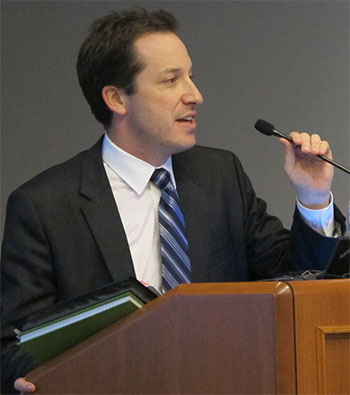
White House economic adviser Jason Miller. [Image: OSA]
5 November 2014—The political realignment in yesterday’s midterm U.S. elections—in which the Republicans captured control of both houses of Congress—promises significant friction in Washington over health care, tax policy and a host of other hot-button issues. But according to Jason Miller, a senior White House adviser on economic and manufacturing policy, the election results won’t necessarily slow a number of administration and congressional initiatives already under way to boost photonics and advanced manufacturing. Miller’s remarks came during a presentation on Tuesday at the annual forum of the OSA Industry Development Associates (OIDA) in Washington, D.C.
Speaking in the middle of Election Day, when the results of the contest were still open, Miller—a deputy director of the National Economic Council, and special assistant to the President on manufacturing policy—touched in particular on the Revitalize American Manufacturing and Innovation Act (RAMI). The RAMI legislation, which includes language suggesting photonics as an area of investment consideration via a new set of federally supported manufacturing innovation centers, has passed the House and is currently in the Senate for consideration.
Miller noted that, whatever the results of the election, the administration would move to get the RAMI legislation enacted during the so-called lame-duck period between Election Day and the swearing-in of the 114th Congress this January. “There’s clear bipartisan support for that bill, and we’re pushing for that as an administration priority—to get that done during the lame duck, so that we don’t have to start over with the next congress,” said Miller. “While there’s a little bit of unpredictability, this is something that we think they should be able to get done.”
The White House adviser also mentioned another bright spot for photonics in the near term: the recently announced Integrated Photonics Manufacturing Institute, a public-private partnership under the aegis of the Obama Administration’s National Network for Manufacturing Innovation (NNMI). The NNMI aims to provide structures to bridge the “valley of death” between the development of new technologies in academia and government and their commercial production, with a particular focus on improving competitiveness in advanced manufacturing.
According to Miller, the Administration is “pretty optimistic” about the prospects for the new photonics institute, for which the Department of Defense, the institute’s principal administration sponsor, is currently seeking bids. But, he noted, “these big consortia are hard—they’re a difficult mechanism to start up and operate on an ongoing basis, and we’re continuing to work on that.” Miller observed that the photonics institute includes “a larger investment from the federal government than any of the previous institutes that we’ve launched,” a fact that he partly credited to the “overwhelming industry push around this topic” from the photonics community.
“These are the kinds of institutions that provide, in the broadest sense of the word, infrastructure for the United States to be competitive,” Miller said. The new institutes envisioned under the RAMI legislation and the NNMI, he suggested, offer both a place to boost human capital through training, and a framework for “de-risking” the development of new technologies to lower the cost of new products and speed their time to market. “We see this as an important piece for building the foundation for U.S. manufacturing competitiveness over the next decade.”
In a larger sense, Miller also pointed to the role of the individual states as sources of innovation funding within the U.S. federal framework. “States spend substantially more, in the aggregate, on economic development than the federal government does,” he said. And such efforts, he continued, can help to build a strong human-capital base that, over time, can result in economic positive feedbacks for a given region that go well beyond the sway of any individual company.
“One of the things we’ve been hoping for with these [administration-led] manufacturing institutes,” Miller said, “is that, going forward, this is not just a federal-funding activity—that you’d see a bunch of states launching some of them” as well. And he noted that the RAMI legislation in particular is structured in such a way that non-federally-funded, state institutes could become part of the larger federal network at their discretion. “To the extent that federal activity spurs more state investment—whether it’s in workforce or technology development—I think that’s generally positive, and we’d encourage ways to link it together.”
